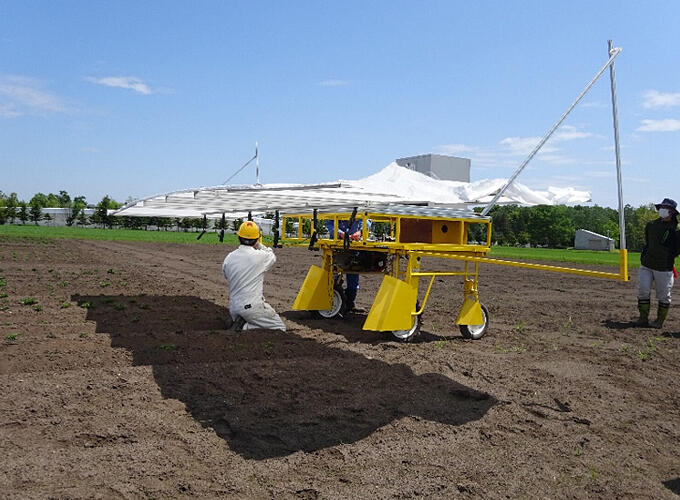A research group led by Director Hiroaki Taniguchi of the Collaboration Promotion Section, National Center for Seeds and Seedlings at the National Agriculture and Food Research Organization (NARO) announced on October 31 that the prototype AI system they had developed to assist in the removal of abnormal strains of seed potatoes has achieved an 83% accuracy rate in detecting the variety 'Toyoshiro'. By analyzing video images captured in the field, the AI detects abnormal strains that have mosaic or wilting symptoms caused by disease infection and notifies the operator through sound and image. The target potato varieties will be expanded in the future, with the aim of introducing them to general production sites in fiscal year 2025. This system is expected to contribute to significant labor savings in the decision-making process, which is time-consuming even for skilled workers, and to help address labor shortages.

Provided by NARO
Because harvested potatoes are used as "seeds," their multiplication rate is approximately 10 times lower than that of rice and other grains (∼400 times). Importantly, disease infections reduce the yield and quality of the crops. The Plant Protection Act stipulates that the acceptance criterion for seed potatoes is 0.1% or less of diseased (abnormal) strains remaining. However, there are no treatments or effective pesticides for many of the diseases transmitted to seed potatoes.
Owing to an aging population and the heavy workload involved (1.8 times that of general potato cultivation), the areas under seed potato cultivation and the number of farmers have decreased in recent years, and the maintenance and knowledge transfer of cultivation techniques have become an issue. In particular, the labor burden of identifying and removing abnormal strains during cultivation is high, as this work requires specialized knowledge and experience, making it difficult for new entrants to enter the market. NARO had previously conducted interviews with farmers and found that there was a great need for the development of labor-saving technology to remove abnormal strains.
In response to these needs, the National Center for Seeds and Seedlings, Hokkaido Agricultural Research Center, Research Center for Agricultural Information Technology, and Hokkaido Technical Support Center (which are all part of NARO) have collaborated to address this issue. The goal was to develop a support system for detecting abnormal strains.
The system being developed targets the 'Toyoshiro,' 'Konahime,' and 'Kitaakari' varieties, and aims to achieve a detection accuracy of 83% of dwarf and wilting symptoms caused by black foot disease, and mosaic symptoms and leaf blight symptoms caused by viral diseases, with less than 0.1% of diseased plants remaining after 4 inspections by skilled workers. For the purpose of converting the knowledge of skilled operators into AI, the AI-based detection program generated approximately 35,000 sets of teacher data for the target varieties at different growth stages. By training it on a deep-learning model, the detection program makes an automatic decision.
The prototype comprises a commercially available field management vehicle equipped with an awning, six portable cameras, and a personal computer, which are used to improve the system's accuracy.
Traditional operator inspection involves visually inspecting two ridges. By contrast, this system detects abnormal strains in six ridges at once while traveling at a speed of 2 km/hour. The worker walks alongside the vehicle and pulls out the abnormal strains that are detected. In the demonstration test, the target detection rate of 83% was achieved for "Toyoshiro." In addition to aiming for similar detection rates for the remaining two varieties, the research group will work to improve the accuracy of the detection program, make the system more uniform, and use the system to consolidate and manage data.
Additionally, preparations are underway to create a model to expand the target varieties to include Irish Cobbler and May Queen. The price is expected to be 2-3 million yen (not including the vehicle). In the coming fiscal year, the research group aims to preliminarily introduce the system to the breeder's seed production at the National Center for Seeds and Seedlings. Then, with the cooperation of general farmers, the plan is to apply and begin to test the practicality of the system in the field in fiscal year 2025. In the future, the research group plans to be able to track the location of abnormal strains.
Taniguchi commented, "In the year after next, a system for detecting abnormal potato strains will be in operation at seed and potato production sites in Hokkaido, so we hope farmers will look forward to it. The introduction of this system is expected to increase the productivity of seed potato farmers and encourage new entrants to the market. We believe that if this system is widely adopted, we will be able to achieve a V-shaped recovery from the current situation where total potato acreage has fallen below 5,000 hectares and continues to decline."
This article has been translated by JST with permission from The Science News Ltd. (https://sci-news.co.jp/). Unauthorized reproduction of the article and photographs is prohibited.




